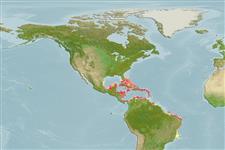Actinopterygii (ray-finned fishes) >
Perciformes (Perch-likes) >
Serranidae (Sea basses: groupers and fairy basslets) > Serraninae
Etymology: Hypoplectrus: Greek, hypo = under + Greek, plektron = sting, spur (Ref. 45335).
Environment / Climate / Range
Ecology
Marine; reef-associated; depth range 3 - 30 m (Ref. 9710). Tropical, preferred ?
Western Central Atlantic: Jamaica, Cayman Islands, Florida (USA), Bahamas, Greater Antilles, Lesser Antilles and Honduras.
Size / Weight / Age
Maturity: Lm ? range ? - ? cm
Max length : 13.0 cm TL male/unsexed; (Ref. 9710)
Short description
Morphology | Morphometrics
Head yellow, body black to brown (extent of the yellow and black portions can vary). The yellow and black portions are divided by a diagonal line that extends from the nape posteriorly and ventrally to the anal fin. Face and all fins yellow. Pectoral fins pigmented. Head with iridescent blue lines (as in butter hamlet but the lines are fewer in number and more pronounced). Two black spots bordered by iridescent blue may be found on the snout in the region of the nares.
A solitary species (Ref. 26340) inhabiting rocky or coral reefs, often near staghorn coral (Ref. 9710). Travels in pairs and remains close to the bottom (Ref. 26938).
Life cycle and mating behavior
Maturity | Reproduction | Spawning | Eggs | Fecundity | Larvae
Domeier, M.L., 1994. Speciation in the serranid fish Hypoplectrus. Bull. Mar. Sci. 54(1):103-141. (Ref. 26407)
IUCN Red List Status (Ref. 115185)
CITES (Ref. 94142)
Not Evaluated
Threat to humans
Harmless
Human uses
Aquarium: commercial
More information
Common namesSynonymsMetabolismPredatorsEcotoxicologyReproductionMaturitySpawningFecundityEggsEgg development
Age/SizeGrowthLength-weightLength-lengthLength-frequenciesMorphometricsMorphologyLarvaeLarval dynamicsRecruitmentAbundance
ReferencesAquacultureAquaculture profileStrainsGeneticsAllele frequenciesHeritabilityDiseasesProcessingMass conversion
Tools
Special reports
Download XML
Internet sources
